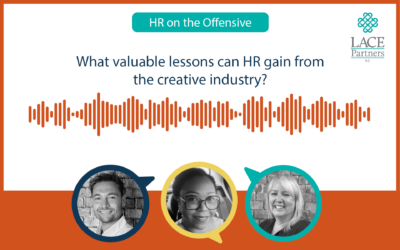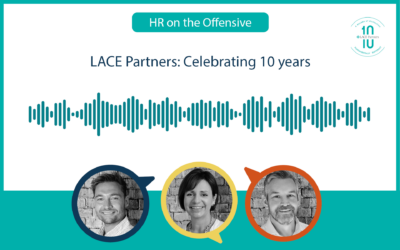What is best practice when it comes to using data metrics to measure and monitoring your diversity, equity and inclusion (DE&I) practices? What are common data points companies are using? We explored this in one of the recent HR on the Offensive podcasts released late last year, with the team from The Clear Company, who have written a guide to data metrics in DE&I. Maria Carolina Baggio, Rhiannon Alexander spoke to Chris from LACE Partners.
What are the most common types of data companies are collecting?
Unfortunately, many of the organisations we speak to collect little – if any – data on diversity. Often this is because of uncertainty around what to collect and where to begin. Whilst data points around gender, age and data related to diversity are most frequent in usage, in terms of the richer data collection, it is clear more work is still to be done. Organisations are aware that they must start collecting data on DE&I metrics, but the fear of not collecting in the right way is often also seen as a barrier. An example of which that some organisations report ethnicity data in terms of “white” and “non-white” which is clearly not inclusive enough. The solution is to report correctly so that the data can become meaningful.
That is why we decided to create the data metrics guide on collecting DE& I data. The guide gives a framework to businesses that talks them through data collection, data analysis and data distribution.
We have also seen how some organisations have sensitive data that may be difficult for an employee to disclose, so the guide is there to help businesses to think about how to structure their collection of DE&I data so that the individual feels respected.
Transparency is key
Deciding on what data to collect and how to collect that data is of course important and the guide we created can help this, but what is crucial for both employers and employees is to be transparent with how you are using the data you are collecting. Make employees aware who has access to their data, what it’s going to be used for, how it’s going to be reported and how their data will be used to improve inclusivity. Having the conversation in a respectful manner is important. Companies may feel intimidated to collect sensitive data, but it is important to seek out that best practice approach for collecting data.
How often should businesses be analysing DE&I data?
Ultimately it does vary depending on the business. But it is also important to consider which questions you are trying to answer with the data, what is it you are trying to monitor, etc. The answers to these questions will highlight how often you should be collecting analysing, reporting the data.
Our recommendation is every six months or annually. An engagement survey, for example, can be done every six months or yearly. Data collection doesn’t have to be as often for this survey as it is looking at cultural change which tends to take while to occur. On the other hand, if you are trying to monitor hiring and recruitment data collection should be carried out every application so that you are able to get every data point. Data collection should be attempted at every application because applicants will not always disclose all their data. Additionally, how often that data should be reported and reviewed, depends on how urgent and the level of priority the task you are trying to use this data for has. If the data changes quickly, it would be beneficial to measure and monitor the data at shorter intervals to observe that change.
Are there any data points businesses are more focused on now than they were pre-pandemic?
Flexible/agile working has been an obvious example of a shift since before the pandemic. Organisations are asking about the desire for flexible working more and returning to the office more often. The answers to these questions will change as the situation itself continues to change. Organisations may have collected that data last month however, people’s needs for flexible working and remote working may have changed within that span of time. It is a constantly moving beast which is why many of the clients we speak to report on this with an ever-increasing frequency.
The impact of unconscious bias
Recruitment is where we can often analyse unconscious bias. Once you analyse the trends for different groups you can find the bottlenecks. The bottlenecks will usually point to unconscious bias. For example, you may have a fair representation of minority, ethnic talent at the attraction phase and the representation stays the same through shortlisting but it drops dramatically at hiring. This points to an issue that may be occurring at the interview stage to be causing that drop. It’s possible in this scenario to see this unconscious bias with just the simple recruitment data.
How can businesses work with their third parties’ providers to ensure they are getting accurate data?
Businesses commonly encounter data challenges like having the right systems to capture the data, there can be disclosure issues and legal challenges, as the data must travel between organisations or individuals. What we recommend to our clients is when a term of engagement has been set up between the parties’ data has to be there as a requirement. Too often the data isn’t there and the parties haven’t even had a conversation about how it’s going to be done and what the requirements are for data collection. The best practice among our clients is to have a real partnership with their third parties. Both parties need to be aware of the importance of diversity and inclusion and the benefit that data will bring to their organisation.
If you’d like to talk to The Clear Company about how they can support you with your approach to DE&I, get in contact with them here.






